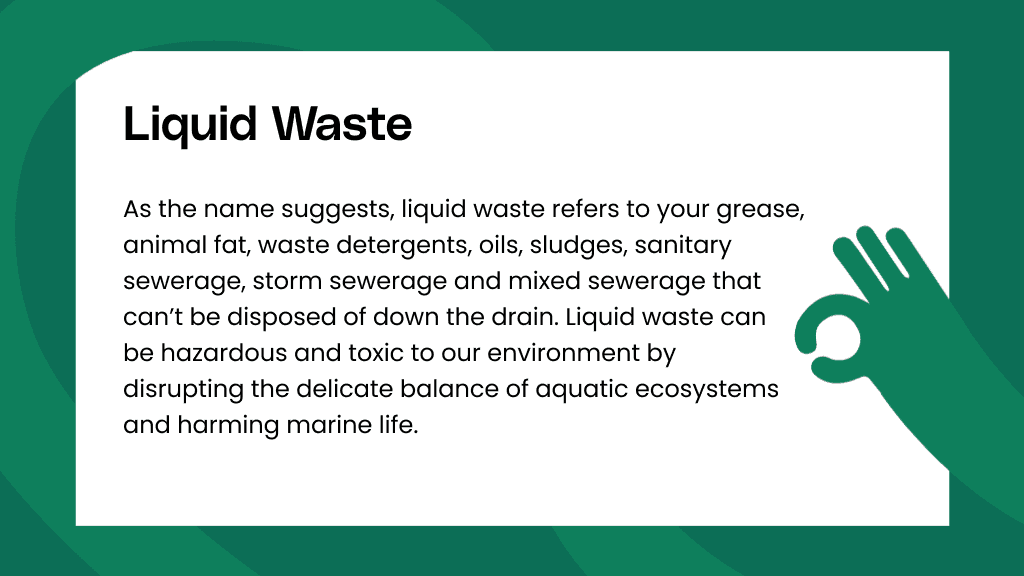The 30-Second Trick For Reclaim Waste
The 30-Second Trick For Reclaim Waste
Blog Article
Some Known Details About Reclaim Waste
Table of ContentsThe Facts About Reclaim Waste RevealedSome Known Facts About Reclaim Waste.How Reclaim Waste can Save You Time, Stress, and Money.Indicators on Reclaim Waste You Need To KnowRumored Buzz on Reclaim Waste
Domestic sewage waste refers to the waste and items from a property septic tank. The correct monitoring and disposal of residential sewage waste require liquid waste to be transferred to a sewer treatment plant where the appropriate techniques and equipment are applied to purify and dispose of waste.
Commercial waste frequently consists of possible risks, such as flammable products or a mixture of liquid and strong waste products, and needs an advanced and detailed disposal process. The disposal of industrial waste normally involves the filtering of waste before transport to make certain risk-free and correct disposal. Industrial waste is developed from byproducts and overflow of commercial processes and manufacturing.
This sort of waste can not use the exact same sewer management transportation or procedures as septic or business fluids. The commercial waste management process needs the examination and testing of liquid waste before it undertakes the disposal procedure (liquid waste removal). Drainage waste is the liquid waste that comes from runoff and excess stormwater in highly populated areas or cities
Overflow waste can trigger contamination and flooding otherwise managed properly. Learn much more concerning drain cleaning and waste administration. Guaranteeing appropriate waste monitoring can prevent disasters and reduce ecological injury. Both people in household setups and specialists in commercial or manufacturing sectors can gain from comprehending the processes and regulations of liquid waste management.
Reclaim Waste - Truths
Get in touch with PROS Services today to find out regarding our waste management and disposal solutions and the correct methods to take care of the liquid waste you create.
(https://moz.com/community/q/user/reclaimwaste1)Do you know what occurs to your water when you end, purge the commode or drain the cleaning maker? No? Well, it's worth knowing. This supposed 'wastewater' is not just an essential resource yet, after treatment, will be launched to our land, waterways or the ocean. Used water from commodes, showers, baths, cooking area sinks, laundries and commercial processes is referred to as wastewater.

water made use of to cool down equipment or tidy plant and equipment). Stormwater, a form of wastewater, is runoff that streams from farming and urban locations such as roofings, parks, yards, roads, paths and rain gutters into stormwater drains pipes, after rainfall. Stormwater flows untreated directly to neighborhood creeks or rivers, at some point reaching the sea.
A Biased View of Reclaim Waste
In Queensland, the majority of wastewater is treated at sewer treatment plants. Wastewater is moved from domestic or commercial websites via a system of sewers and pump terminals, known as sewerage reticulation, to a sewage therapy plant. City governments develop, keep and operate most sewage treatment plants. Operators are licensed under the Environmental Security Act 1994 to release cured wastewater at an acceptable environmental requirement into waterways.
The Department of Natural Resources suggests local governments concerning handling, operating and maintaining sewerage systems and therapy plants. In unsewered locations, neighborhood governments may need owners to set up private or home sewage treatment systems to treat residential wastewater from bathrooms, kitchens, washrooms and washings. The Department of Natural Resources authorises making use of house systems when they are proven to be reliable.
A lot of stormwater gets no therapy. In some new subdivisions, treatment of some stormwater to get rid of trash, sand and gravel has begun utilizing gross pollutant catches. Wastewater treatment happens in 4 phases: Gets rid of solid issue. Bigger solids, such as plastics and various other items incorrectly released to drains, are removed when wastewater is gone through screens.
Wastewater then streams right into big tanks where solids clear up and are gotten rid of as sludge. Grease and scum are skimmed from the surface. Uses little living organisms referred to as micro-organisms to damage down and get rid of staying liquified wastes and great bits. Micro-organisms and wastes are included in the sludge. Removes nitrogen and phosphorus nutrients that might cause algal flowers in our rivers and threaten water life.
Some Known Details About Reclaim Waste
Nutrient elimination is not available whatsoever sewage treatment plants because it needs costly specialist devices. It is becoming more common in Queensland. Clear fluid effluent generated after therapy might still have disease-causing micro-organisms. If this effluent is launched right into waterways such as rivers or the sea, the micro-organisms will ultimately die out.

This typically means wastewater has to be treated or impurities eliminated before it can be released to rivers. Many wastewater streams into the sewerage system. Under the Act, city governments administer approvals anchor and permits for ecologically relevant activities (ERAs) involving wastewater launches that may have a local impact. The division provides authorizations and licences to ERAs including wastewater releases that may have a local or statewide influence.
Reclaim Waste Fundamentals Explained
Otherwise, examples are taken for research laboratory evaluation. Commonly many examinations are required to develop the levels of each of the different toxins such as oils, hefty metals and pesticides in water. Surveillance gives factual info concerning water top quality and can confirm that licence problems are being satisfied. The details obtained with tracking supplies the basis for making water top quality choices.
Report this page